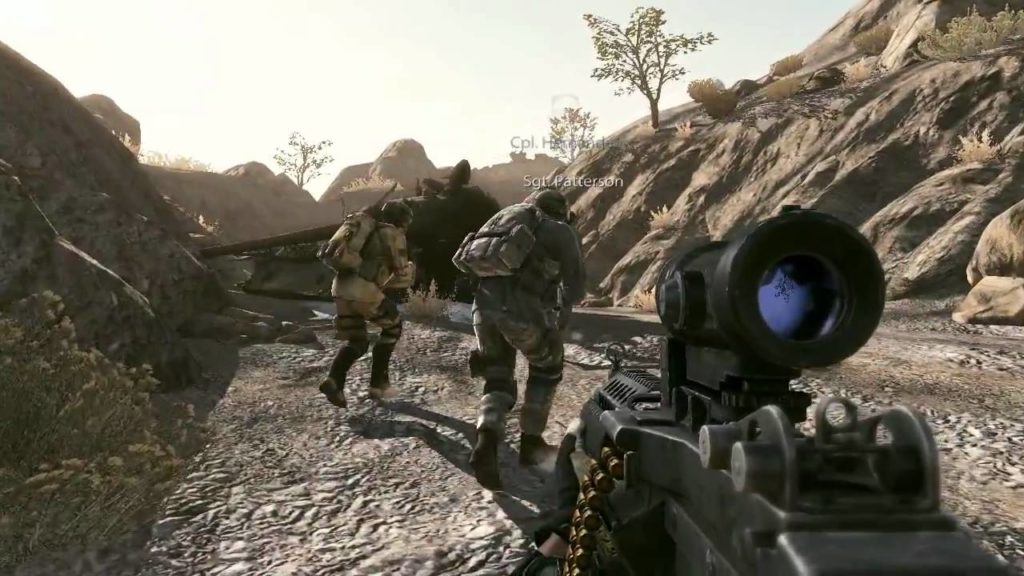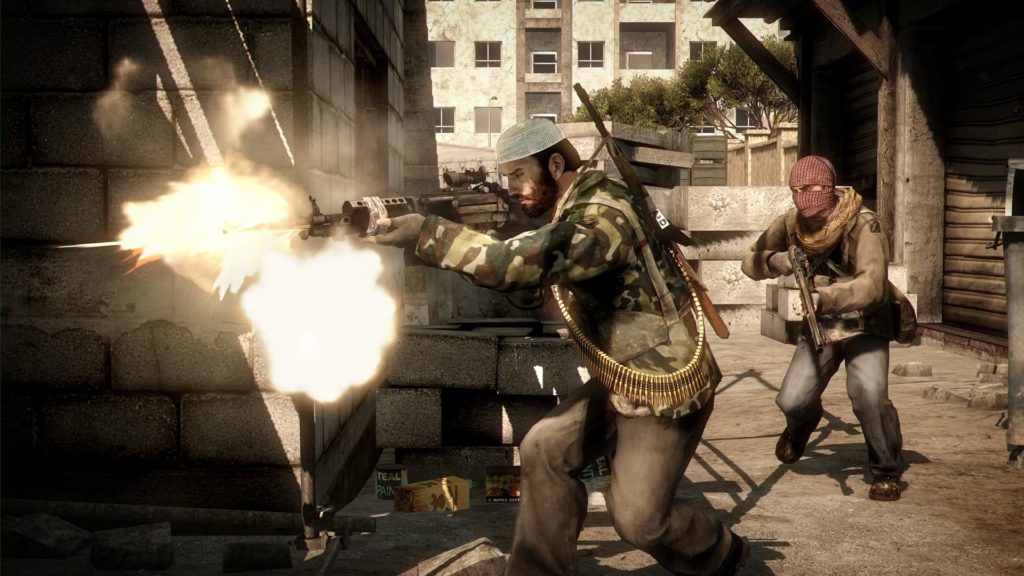Despite the name, this Medal of Honor is in fact the sixth game in the series to be released on PC (including two expansions) with countless spinoff titles having also been released on consoles. Unlike previous games, however, this particular title has managed to attract the attention of a lot of mainstream media – due to the fact that it allows players to play as Taliban in multiplayer.
That controversy (and, perhaps, the media coup for EA) aside, we’re here today to see how the actual game stacks up by itself.
As is the norm in gaming and cinema, this latest iteration signals a reboot for the series – moving it out of World War II and right up to the current day.
What hasn’t changed is that the series is still focused on delivering solidly in both main areas – single and multiplayer. In fact, it’s arguable that EA has taken this goal even more seriously than ever before, tasking the wizards at DICE with tackling the multiplayer stuff while Danger Close (EA LA) tackle the single player side. In fact, the two halves of the game share almost nothing other than the title in common – everything from the interface to the game engine is completely different.
What’s also different is that we were unable to get the Multiplayer part of the game working. On PC, it requires that Punkbuster (the anti-cheat software) is running on your computer, which is installed as part of the (lengthy) install process for the game itself. Despite that process completing successfully, attempting to join servers via the multiplayer game results in an error message that Punkbuster is not installed. Reinstallation, downloading new versions or any of a countless series of online guides to resolve the (obviously widespread) problem were not successful. While it is clear that not all players are similarly affected (there were a lot of active players in the server browser), we were unable to get the game to run in time for this review. As a result, multiplayer gameplay isn’t covered here. Hopefully we can get this situation resolved at some point, upon which we’ll do another article to cover that side of the game. All we can do at this stage is, frustratingly, back up that the multiplayer game at least looks good on paper (especially with the seasoned DICE team driving that side of things).

What is immediately obvious on first playing the game (or watching a trailer) is that Medal of Honor has the Call of Duty games square in its iron sights. Way behind the 8-ball in bringing their flagship FPS series into the modern era (Call of Duty: Modern Warfare 2 is already old news) gamers will have high expectations going into this one. After all, this is EA and they already have a fair idea of what to expect from a tier-1 shooter. So are EA successful in emulating Call of Duty? Not really. That’s not to say Medal of Honor is a write-off but compared to CoD, it really does feel like a B-movie experience.
First up, the basic gameplay. Running around and shooting at things remains at the core of the experience, as expected. Like CoD, exactly whose boots you’re running around in will vary from time to time to push the story along, but the shooting (and who you’re shooting at) remains largely consistent throughout.
Weapons are many and varied, however one thing which is a constant is just how awesome they feel to use. Everything about their implementation works, even at a primal level. They feel great with extremely visceral results; enemies shudder as they are peppered with the explosive impact of dozens of rounds of the US Army’s finest ammunition. Heads burst open as their host collapses backwards, instantly dead even before the gore that burst from their skulls hits the sand behind them. If you’re under any illusion that this game is suitable for minors, it’s time to hand over your parenting license – this is NOT a game for children. About the only thing about the guns which is less satisfactory is the unpredictable manner in which materials behave when taking incidental damage; it’s not clear if you can shoot your heavy machine gun through tin sheets, for example, although masonry and dirt kicks up a satisfying burst of dust when impacted.
You spend most of your time running around with AI controlled squadmates who will alternately lead you around or follow your lead, depending on what’s going on. At no point can you actually instruct them, however you will occasionally be proffered a lift over a wall or will have some other similar scene-advancing interaction with them. They’re pretty stupid but they’re (apparently) invulnerable so you don’t need to be too worried about them. Just be prepared to listen to them whining about you shooting them because they’re not smart enough to avoid your cone of fire in a fight, often wandering into your suppressing fire or similar.
Enemies are similarly bereft of intelligence; something that is initially masked by their scripted behavior (which makes them seem quite smart). As soon as you do something slightly outside of the box, however, like flanking them or chucking a grenade, you realise they’re really just moving obstacles and, aside from their predictable weapons fire, that they offer no real threat if you’re prepared to doggedly pick them off.

Like CoD, MoH is a scripted, linear experience. MoH manages to make this experience feel more artificial and claustrophobic somehow, frequently putting you into an artificial valley or similarly walled-off area so you have no option as to which way you go next. It also suffers from “magic gates” syndrome, where sections of the environment (often actual gates) will magically open once you’ve defeated all the enemies in the current area. Despite the credibility given by the real-world story, the powerful weapons and the relatively desert-like setting, much of the sense of realism is lost by the use of these archaic gameplay mechanics.
Not all of the game is run’n’gun, with numerous CoD-like minigames chucked in to keep things interesting as you progress. A frequently revisited mechanic is the (now standard) remote weapons platform, where you paint targets with your laser binoculars and select the various weapons to deploy from a circling aircraft. These sections are pretty fun but they all have a “fairground” feel to them, where you feel like you’re actually participating in a shooting gallery rather than any sort of real-world engagement. It also seems strange that, given the lack of any sort of consistent anti-air capability, this sort of overwhelming firepower is only rarely deployed. Depicted as tide-turning in its ability, that most of the grunt work in the game falls on the lowly foot soldier seems like rather poor use of resources.
Other minigames see you in charge of the guns on board an Apache-like helicopter gunship, firing hellfire missiles and generally blowing the crap out of things – sometimes from a great distance. Unfortunately, like the rest of the game, even these sections can suffer from the game’s poor ability to communicate your objectives. Sometimes you’ll find yourself failing without realising you had something specific to do, while other times you’ll fail over and over because you’re unable to understand what you’re supposed to do based on the instructions you were given.
Visually MoH is pretty disappointing. Environments lack detail and, in general, feel clinically devoid of any touches of reality. Lighting is poor, with a mish-mash of overly bright and overly dark areas resulting in a very unrealistic combination. CoD was incredibly good in this area so MoH was going to have to be something very special indeed to compete – instead, it’s decidedly average. Character animations are ok but characters frequently clip through the ground, standing ankle (or even calf) deep in rocks or other solid-looking material. They also get stuck inside objects, which is inexcusable when said object was just thrust through the wall in a scripted event (reloading this particular checkpoint over and over resulted in the same NPC getting stuck inside the object over and over).
Sound, however, is one area where MoH leads the pack. The guns in particular are unbelievably thumpy, with similarly grandiose explosions packing a massive punch. Add in the satisfyingly realistic (assumed) sound of bullets whizzing overhead and the crunch of bullet vs. bone and you have some incredibly intense combat. The fact that it looks a bit average and you’re obviously in a linear event is somehow forgotten thanks to the incredibly intense way in which the sound rounds out the experience. It truly is remarkable, thanks in no small part to solid surround sound and sub-base. Turn it up as loud as you can get away with, you won’t regret it.
So is it worth it? Only you can really decide that and it will all come down to how you feel about linear shooters. It’s more linear than CoD but arguably the combat is more viscerally executed, with kill-shots being in no doubt whatsoever. It’s also somewhat more clumsily implemented, with pretty cludgy AI and a general lack of polish throughout. Multiplayer is a bit of a roulette for now, although we’re sure EA will eventually get those of us on the sidelines into the battlefield.
Our assessment though is that it’s a worthy experience, thanks in no small part to the sense of urgency that comes from the story being plucked straight from the world’s headlines. Hopefully the sales from this are enough to encourage EA to commit to another iteration, which would then (hopefully) have a bit more time spent polishing up the experience. It has the basic building blocks of something spectacular but for now will need to be satisfied with a somewhat less effusive “good effort” closing comment.